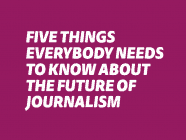Radio broadcasting remains a powerful medium of modern communications: in the United States, more than 240 million people use it every week. In times of crisis and disaster, it is often the medium of last resort. But its place of primacy in our modern media environment is being threatened by new technologies that are redefining just what “radio” is, and by an ideological blind-spot in the U.S. policymaking process that radically constrains creative thinking about what radio’s future potential might actually be.
Radio is the last of the traditional analog mass media to negotiate the communicative phenomenon known as “convergence.” Convergence refers to the ongoing digitalization of all media and embraces the notion that previously separate mediums will inevitably “converge” in such a way so that their distribution takes place over a uniform conduit, such as the Internet. From a purely technological standpoint, this conception is useful.
However, scholars and policymakers that study convergence often fail to address all three important factors which make the phenomenon possible, of which the development of new technologies is only one; the other two include industry strategy and public policy.
The development of digital radio in the United States illustrates the weakness in assuming that there is something “inevitable” about convergence. Rather, it shows how neoliberalism, or the fundamental belief that marketplace relations are the most inherently efficient means by which to organize modern society, has actually led to democratic deficits in communications policy.
While the majority of the industrialized world has adopted a digital radio system (called DAB or DAB+) which places digital signals on new spectrum allocations wholly separate from the traditional AM and FM bands, U.S. broadcasters instead opted for a homegrown solution dubbed HD Radio, which places digital signals next to and underneath existing analog signals.
The development of HD Radio was torturous: it is impossible to change the laws of physics to fit new radio signals onto spectrum already crowded with them. So instead, HD Radio’s proponents convinced U.S. media regulators to change the science on which radio spectrum is allocated—fundamentally transforming the definitions of “channel” and “interference” to accommodate the HD system with utter disregard for the implications. Furthermore, HD Radio is a closed system, forcing every U.S. radio station into Microsoft-style licenses with its proprietor in order to broadcast digitally.
Historically, the government has been the ultimate gatekeeper to the public airwaves; moving this function partly into the private domain is a triumph of neoliberalism unparalleled in the history of U.S. broadcast policy. During the Federal Communications Commission’s unanimous vote to certify HD Radio for deployment in 2002, Democratic Commissioner Michael Copps openly remarked that “a few questions remain to be settled, including how [HD Radio] will function in the real world,” but expressed confidence that the market would sort out radio’s digital transition on its own.
A dozen years later, the market seems to have spoken: just 13% of U.S. radio stations broadcast in HD. Only 2% of radio listening takes place via HD signals; outside of new automobiles, it’s difficult to find a digital receiver. Surveys of radio listeners suggest that the vast majority still don’t know what HD Radio is, often confusing it with satellite or streaming services. Meanwhile, the growth and reach of those services are fundamentally transforming the public definition of what radio itself is, provoking anxiety among legacy broadcasters who worry about the marginalization they are in large part responsible for.
Irrespective of the technology, radio’s digital transition is a gamble, and the players everywhere are the same: incumbents more concerned with preserving the status quo they are in evolution, and regulators so overwhelmed by the Internet that broadcasting policy has been effectively outsourced to the incumbents. It’s an unproductive cycle, and one that clearly demonstrates the intellectual bankruptcy of the neoliberal worldview. The ultimate loser is radio itself, as a technology that once transfixed entire peoples stands to be reduced to a medium of last resort.
The good news is that potential market failures open up opportunities to reconsider the status quo—a critical juncture, perhaps, to re-envision the future of radio. Undoubtedly, it too will be all-digital and multiplatform, but the steps between there and here aren’t yet fully defined. Radio’s digital transition is also an opportunity to reinforce the notion of democratic participation in the formulation media policy, even if only to restore a semblance of sanity to it.
Photo credit: Highway Agency / Flickr Cc
Tags: AM, convergence, digital, dilemma, Federal Communications Commission, FM, HD Radio, Internet, media, neoliberalism, News, Radio, radio system, traditional











































